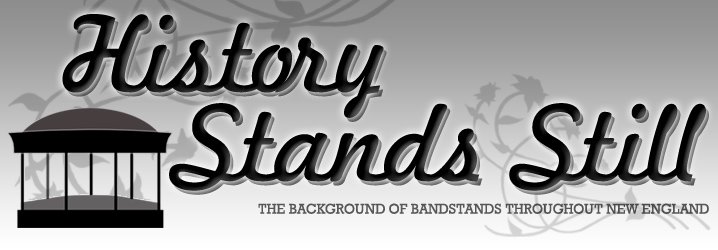EXETER NH
The Swasey Pavilion
Downtown Exeter
Built - 1916


The southeastern New Hampshire town of Exeter is located within 10 miles of the Atlantic Ocean and situtated on both the freshwater Exeter River and the salty Squamscott River which intersect through a number of dams within the center of town. Exeter is also the home of Phillips Exeter Academy, the American Independence Museum and several sculptures by Daniel Chester French. Many of the town's buildings are fine examples of Federal architecture.
The town can also boast having one of the most unique and ornate old bandstands in the country and a classic example of Greco-Roman architecture. The structure is also considerably older than many New England bandstands being built in 1916 through the generous donation of a Mr. Ambrose Swasey as a gift to his beloved town of Exeter. Mr. Swasey was a wealthy industrialist who wished to give back something to his hometown and, with the advice of the renowned Exeter-born sculptor Daniel Chester French, mentioned above, and the equally famous architect Henry Bacon, a gift of a small pavilion suitable for band concerts in the town square was decided upon.
At a special town meeting held in mid-January 1916, the town accepted this generous offer and on the following August 10th, a very handsome structure was dedicated with a large appreciative audience of citizens of Exeter who accepted the keys from Mr. Swasey. "The Bandstand' - the informal name of the structure with the formal one being the "Swasey Pavilion," has marked the center of the town since that time. Mr. French and Mr. Bacon were the ones who designed the magnificent structure and were very prominent in an association with other great American monuments including the Lincoln Memorial, thus the bandstand is a very special pavilion, indeed.
The structure has a granite foundation with eight marble columns supporting a marble architrave. The ceiling is mosaic and represents a sunburst, and the copper roof is ornamented with sixteen gargoyles of lions' heads and a pine cone finial. The bandstand thus resembles a miniature classic temple and is definitely a prominent fixture in the square and extremely noticeable.
With such a longevity as the structure has had, many events have taken place upon its raised floor including, of course, countless band concerts by the wonderful Exeter Brass Band which originated in 1847. Also of importance to the citizens of Exeter and part of the history of the town, was when an "Honor" flag was proudly flown from the pavilion to show that the citizens had over-subscribed for "The Liberty and Victory Bond drives in 1919. In the mid 70s, President Ford spoke from the bandstand.
Lions Club auctions, Rotary Club scholarships, apple sales, Kiwanis bike races, Santa Claus' visits at Christmas as well as the bandstand being lit up during the holiday season, have all been held on or near the bandstand. Across the street on the steps of the town hall, politicians have campaigned and New England Rock groups have performed once each summer for street dances.
When the town of Exeter defeated the $1,200 warrant article for band concerts in 1959, the good townspeople stepped in to continue the tradiion of having these band concerts. Most notably, Paul LaPerle, a local contractor, raised private donations for 3 concerts with the local musicians of the Exeter Brass Band kicking in for 1 concert. Mr. Thomas Brewitt gave a donation of 1 concert also in memory of her husband and the family has continued the tradition since with the Exeter Recreation Department covering other concert costs to date.
Exeter's wonderful old bandstand is the second one the town has had with the first wooden structure being built in 1895 in the same location but condemned by the Board of Health and destroyed in 1905.
INFORMATION SUPPLIED BY:
Judith A. Kennedy, Reference Librarian
Exeter Public Library

No comments:
Post a Comment